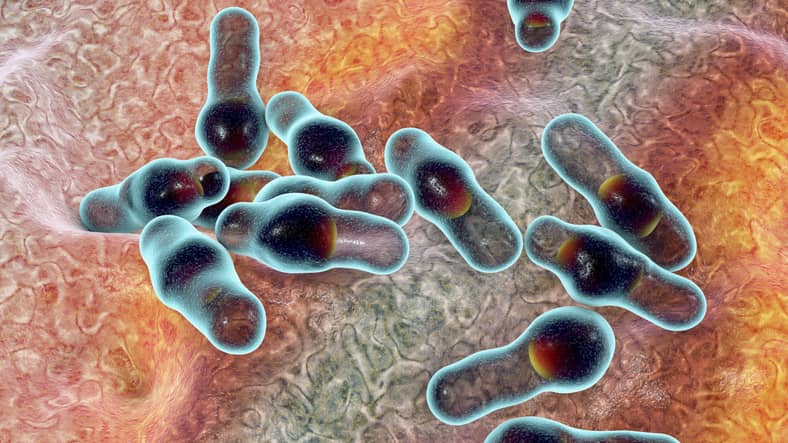Listeriosis is a foodborne illness that usually develops when you eat contaminated food.
It’s caused by a bacteria called listeria monocytogenes, found in raw (or unpasteurised) dairy produce, ready-to-eat meats and certain fruits and vegetables.
Listeriosis is relatively rare and most cases go away on their own, but certain people are at greater risk from infection.
Who’s most at risk from listeriosis?
Anyone can get listeriosis, but you have a higher risk of developing a severe infection and/or having complications if:
- you’re pregnant
- you’re over 65
- you have a weakened or compromised immune system
If you’re pregnant, listeriosis can also cause serious complications — including miscarriage and stillbirth. In fact, the World Health Organization (WHO) say that pregnant women are 20 times more likely than other people to get listeriosis.
So it’s important to make sure that you’re familiar with the foods that can cause listeriosis and know how to spot and prevent the condition.
If you’re over 65 or have a compromised immune system the risks are slightly higher, but anyone in an at-risk group is advised to avoid foods known to harbour listeria infestation. They should take special precautions to reduce their chances of infection.

What are the symptoms of listeriosis?
Non-invasive listeriosis
Healthy people may get a mild form of the disease called non-invasive listeriosis. This normally causes symptoms of food poisoning, including:
- diarrhoea
- fever
- chills
- headaches
- muscle pain
Most cases of non-invasive listeriosis clear up on their own, and experts say that you’ll typically get better within 1 to 7 days.
Invasive listeriosis
If listeria bacteria get into your bloodstream, they can spread to other parts of your body — causing serious complications like meningitis (swelling of the tissues around your brain and spinal cord) and sepsis — where your immune system overreacts to an infection and starts to attack your tissues and organs.
This is known as invasive listeriosis and it normally affects elderly people or people with a compromised immune system — such as people who are being treated for cancer or have AIDS.
Symptoms normally take 1 to 4 weeks to appear, but it’s worth noting that some people have reported symptoms up to 70 days after eating contaminated food.
It’s estimated that 90% of people who get this form of listeriosis need to be treated in hospital.
If you think you might have symptoms of invasive listeriosis, see a doctor as soon as you can. They will be able to diagnose the illness and prescribe medication to treat it.

What are the symptoms in pregnant women?
Diagnosing listeriosis in pregnant women can be hard because it doesn't always cause gastrointestinal symptoms like vomiting or diarrhoea. Instead, pregnant women often get relatively mild symptoms of fever, fatigue or muscle aches. Some women don't experience any symptoms.
But listeriosis can be very dangerous if the bacteria spread to your placenta and your unborn child — causing miscarriages, stillbirth or premature delivery.
If you’re pregnant and you think you might have listeriosis, it’s important to see a doctor as soon as you can. They will prescribe medications to treat the infection and stop it from spreading to your baby.
How is listeriosis diagnosed and treated?
If a doctor thinks that you might have invasive listeriosis, they will take some blood or do a spinal tap. This is where a needle is used to take a sample of the fluid that surrounds your brain and spinal cord.
These samples will then be sent to a laboratory and examined for traces of listeria.
If you're diagnosed with invasive listeriosis, you will normally be given antibiotic medications to treat the infection. You may also be admitted to hospital if you're very unwell.
What foods cause listeriosis?
The germs that cause listeria can hide in a number of different foods. In the past, outbreaks have been linked to deli meats and hot dogs. But experts say that you can also get listeria from:
-
raw (unpasteurised) milk — some milk products are pasteurised to kill any harmful bacteria, but milk products that haven't been treated in this way can contain listeria. It’s important to avoid unpasteurised milk if you’re pregnant, elderly or have a compromised immune system
-
soft cheeses made from unpasteurised milk like queso fresco, Camembert or feta — look for options made with pasturised milk instead to reduce your risk, or avoid these cheeses entirely if you’re in an at-risk group
-
smoked fish — especially smoked fish that has to be kept cold or refrigerated. Try to look for options that are labelled as ‘shelf-stable’ as these products are less likely to contain listeria
-
refrigerated, ready-to-eat foods like cold cuts of meat, seafood or meat spreads — look for options that can be heated to at least 70C before serving, or avoid them entirely if you’re in an at-risk group. This is also true of fermented and dried sausages, which may be contaminated with listeria
-
raw sprouts — these need warm and humid conditions to grow, and these conditions also encourage the growth of dangerous bacteria like listeria.
-
melons and other raw fruits and vegetables — previous outbreaks have been traced back to cantaloupe melons. You can reduce the risk from these foods by washing them thoroughly, and storing them in the refrigerator

Can I prevent listeriosis?
Unlike other types of bacteria, listeria monocytogenes can survive at very low temperatures. This means that you can’t always kill them by refrigerating or freezing your food.
Listeria infestations can also grow without changing the taste or smell of your food. But they can be killed by cooking or reheating food thoroughly.
If you have a high risk of catching invasive listeriosis, it’s important to follow the manufacturer’s instructions when preparing food, so that you know it’s cooked through.
You should also follow the storage instructions on food labels and make sure that you always eat food by its use-by date.
If you’re going to eat ready-to-eat food items, you should also make sure that you keep them chilled before eating and make sure that you throw them away if they have been in the fridge for more than 4 hours.
Key points
- listeriosis is a relatively rare infection caused by a bacteria called listeria, which is sometimes found on raw (unpasteurised) dairy produce, chilled ready-to-eat foods and soft cheeses
- some people have an increased risk of catching listeriosis — including pregnant women, the elderly and people with a compromised immune system
- most cases of listeriosis are relatively mild, but if it spreads to other parts of your body it can cause serious complications
- in pregnant women, listeriosis can also cause serious complications — including miscarriage and stillbirth
- you can reduce your risk of catching listeriosis by avoiding high-risk foods, and making sure that you clean, cook or store your food properly




